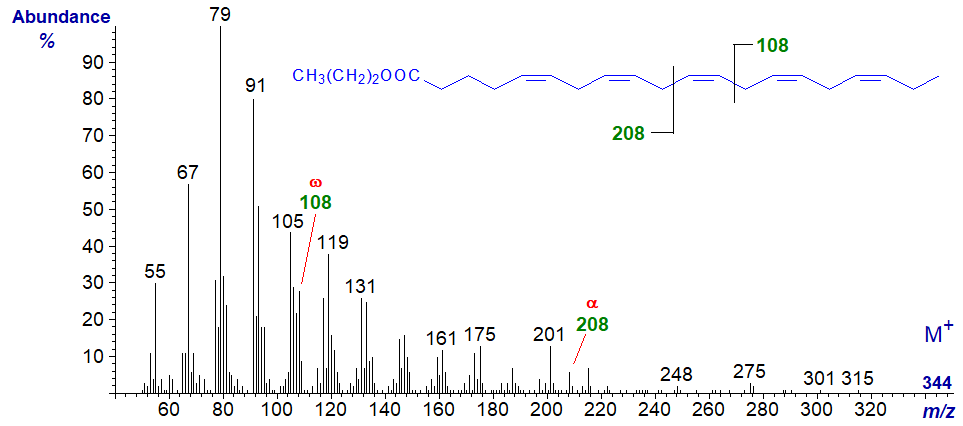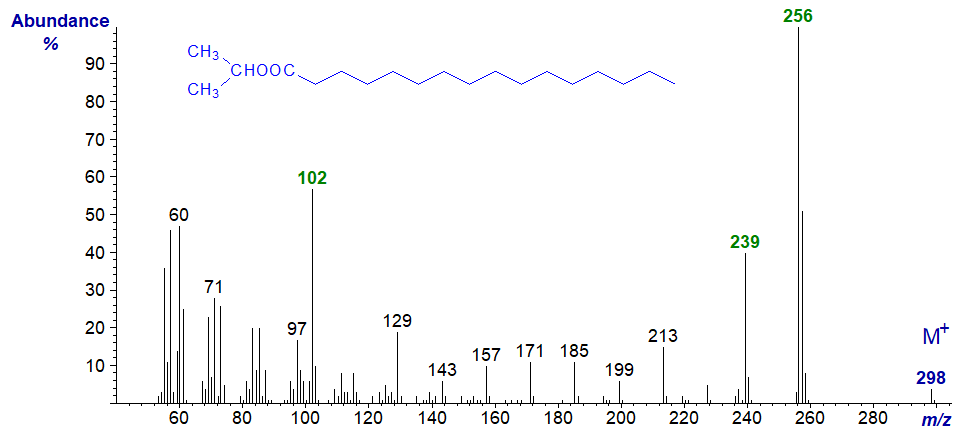Mass Spectrometry of Alkyl Esters -
Ethyl, Propyl and Butyl
While the long-chain wax esters (spectra discussed on a separate web page) can be major lipid components of plant and animal tissues, simple alkyl esters (ethyl, propyl, butyl) occur only occasionally as minor constituents. However, there are often good practical reasons to prepare alkyl esters other than methyl for chromatographic and mass spectrometric analysis or for commercial purposes. Trimethylsilyl esters are discussed in a separate document. Many of the spectra that follow may not have been published (or at least illustrated) formally elsewhere. Readers are referred to our web pages on mass spectrometry of methyl esters for more discussion of mechanistic aspects.
Ethyl Esters of Fatty Acids
Fatty acid ethyl esters can be found naturally in animal tissues at very low levels in certain circumstances, and they can be a useful marker for excessive alcohol consumption in humans. I have encountered them as artefacts when methylating reagents have been accidentally contaminated with ethanol, and I am aware that this has happened to others. In addition, purified fatty acid preparations intended for pharmaceutical or nutritional applications are often converted to ethyl esters prior to administration or encapsulation, and they can be analysed in this form. The mass spectrum of ethyl palmitate (Ryhage and Stenhagen, 1959) is –

The spectrum resembles that of the methyl ester, except that the McLafferty ion (the base ion – see our web page on methyl esters of saturated fatty acids) is at m/z = 88 instead of 74. In the high mass range, following the molecular ion, there is an ion at m/z = 255 for loss of the ethyl group, then one at m/z = 241 from a rearrangement reaction involving expulsion of a three-carbon fragment (C2 to C4). An ion at m/z = 239 adjacent to this represents loss of the ethoxide ion ([M−45]+). Comparable features are seen in the spectra that follow. As with other simple esters, the McLafferty ion becomes relatively less abundant with increasing unsaturation.
Mass spectrum of ethyl oleate -

In this instance, the ion for loss of the ethyl group (m/z = 282) is much less abundant than that for the loss of the ethoxide moiety (m/z = 264).
Mass spectrum of ethyl linoleate -

With fatty acids with three or more methylene-interrupted double bonds, it is customary to look for the 'omega' ions at m/z = 150 or 108 to identify fatty acids of the n−6 and n−3 families, respectively (see our web page on methyl esters of trienes). As these are formed from the terminal part of the molecule, they are still present in the spectra of other short-chain alkyl esters (together of course with the appropriate ions for other biosynthetic families). In contrast, the alpha ions are formed from the carboxyl end of the molecule and vary with the nature of the alcohol moiety; the values expected can be calculated by adding 14, 28 or 42 for ethyl, propyl or butyl esters, respectively, to those tabulated for methyl esters.
Mass spectrum of ethyl 5,8,11,14,17-eicosapentaenoate (20:5(n-3) or 'EPA') -

As discussed above, the ion at m/z = 108, typical of fatty acids of the (n-3) family in the spectra of methyl esters, is independent of the type of alcohol moiety so is prominent in this spectrum, but the position of the α-ion at m/z = 194 is dependent on the nature of the alcohol moiety (see our web page on methyl esters of trienes).
With a fatty acid of the (n-6) family, the mass spectrum of ethyl 4,7,10,13,16-docosapentaenoate or 22:5(n-6) -

The omega ion is at m/z = 150, as in the spectra of methyl ester, but the alpha ion is now at m/z = 180. Note that in this and the previous spectrum, the molecular ions are not discernible.
Mass spectra of many more ethyl esters in a wide range of chain lengths and degrees of unsaturation, not to forget methyl branches, are available in our Archive pages but without interpretation.
n-Propyl Esters of Fatty Acids
Propyl esters of fatty acids are rarely encountered by analysts, but a few spectra of n-propyl ester are illustrated here for the sake of completeness.
Mass spectrum of n-propyl hexadecanoate (16:0) -

The ion at m/z = 239 ([M-59]+) reflects the loss of a propyloxy ion, while that at m/z = 257 ([M−41]+ or RCO2H2+) is presumably due to the loss of a propenyl moiety. The latter is often the most abundant ion in spectra of saturated long-chain esters. The McLafferty ion is at m/z = 102.
Mass spectrum of n-propyl 9,12-octadecadienoate (linoleate) -

As in the spectrum of methyl linoleate, hydrocarbon ions predominate. The ion representing the loss of the propyloxy ion (m/z = 263) is prominent, but in contrast to the previous spectrum that for loss of a propenyl ion (m/z = 279) is not.
Mass spectrum of n-propyl 5,8,11,14,17-eicosapentaenoate (20:5(n-3) or 'EPA') -

Ions in the high mass range, including the molecular ion, are scarce, but the omega ion for the (n-3) double bond is constant at m/z = 108, while the alpha ion is now at m/z = 208.
Mass spectra of many more n-propyl esters in a wide range of chain lengths and degrees of unsaturation are available in our Archive pages, but without interpretation.
i-Propyl Esters of Fatty Acids
Fatty acid esters of iso-propanol (propan-2-ol) have excellent gas chromatographic properties, and they elute appreciable before other higher aliphatic esters in general and the analogous n-propyl esters in particular. They have been recommended for the separation of positional and geometrical isomers of mono- and polyenoic fatty acids on the polar GC phase CP-Sil 88TM (Wolff, 1992; Wolff and Vandamme, 1992), as all eight possible cis/trans isomers of α-linolenate were separable as the propan-2-ol esters but only six peaks were seen for the corresponding methyl esters. As discussed below, they may have some advantageous mass spectrometric properties in comparison to other simple alkyl ester derivatives.
Mass spectrum of i-propyl hexadecanoate (palmitate or 16:0) -

The spectrum is somewhat different from that of the corresponding n-propyl derivative, though mainly in the relative abundances of certain ions, especially that for loss of a propenyl moiety, the base ion in this instance at m/z = 256 (m/z = 256, [M−42]+ rather than [M−41]+). The McLafferty ion is at again at m/z = 102.
Other than the more abundant ion for loss of a propenyl moiety and in the relative intensities of a few further ions in the high mass region, the mass spectra of i‑propyl 9‑octadecenoate (oleate) and i-propyl 9,12-octadecadienoate (linoleate) differ in minor ways only from those of the n-propyl esters -


When there is a bis-methylene-interrupted double bond system as in the spectrum of i-propyl hexacos-5,9-dienoate -

By analogy with the spectra of the methyl esters of 5,9-dienes, we would expect cleavage between carbons 7 and 8 to give fragments at m/z = 169 and 264; the latter is indeed present, but the former loses 42 amu (i.e., the propyl unit) and instead gives a prominent ion at m/z = 127. With the analogous methyl esters, there is an ion equivalent to [M−49]+, which is believed to be derived from a rearrangement involving the ester moiety, and there is an equivalent ion here now at m/z = 357 ([M−77]+).
The ion for loss of a propyl unit (now at [M−43]+) is apparent even in the spectra of i-propyl eicosapentaenoate (EPA) and docosahexaenoate (DHA), i.e., at m/z = 301 and 327, respectively, so that the molecular weight can be determined at least, in contrast to other simple alkyl esters such as methyl esters. The ω-ion at m/z = 108 is evident in both, but the α-ions are in noisy regions of the spectrum and are barely detectable. It seems probable that the α-ion will undergo elimination of the propyl moieties readily.


In comparison, it is often difficult to determine the molecular weight of methyl esters of polyunsaturated fatty acids because of a lack of diagnostic ions in the high mass region. As isopropyl esters are reputed to have excellent GC properties, it might be of value to study them further.
Mass spectra of many more i-propyl esters in a wide range of chain lengths and degrees of unsaturation are available in our Archive pages but without interpretation.
n-Butyl Esters of Fatty Acids
Butyl esters are sometimes favoured for the analysis of short- and medium-chain fatty acids such as those in milk fat or coconut oil, because of their comparatively reduced volatility. The mass spectrum of n-butyl hexadecanoate (16:0) is -

By analogy with the previous spectra, the ion at m/z = 239 ([M−73]+) reflects the loss of a butyloxy ion, while that at m/z = 257 ([M−55]+) is presumably due to the loss of a butenyl moiety. The McLafferty ion is at m/z = 116. In this instance, the butyl ion at m/z = 56 is the base ion.
As butyl esters are useful for the analysis of short-chain fatty acids, the spectrum of butyl hexanoate (6:0) is illustrated next -

The molecular ion is not discernible, but analogous diagnostic ions to those in the previous spectrum are key features.
The mass spectrum of n-butyl 9,12-octadecadienoate (linoleate) has comparable features to that of the n-propyl ester above -

In this instance, the first significant ion in the high mass region at m/z = 279 ([M−57]+) represents loss of a butyl rather than a butenyl moiety, but this does not seem to be a consistent feature in the spectra of butyl esters of polyenoic fatty acids.
Mass spectra of many more butyl esters in a wide range of chain lengths and degrees of unsaturation are available in our Archive pages, but without interpretation.
References
- Ryhage, R. and Stenhagen, E. Mass spectrometric studies II. Saturated normal long-chain esters of ethanol and higher alcohols. Arkiv Kemi, 14, 483-495 (1959).
- Wolff, R.L. Resolution of linolenic acid geometrical isomers by gas—liquid chromatography on a capillary column coated with a 100% cyanopropyl polysiloxane film (CPTMSil-88). J. Chromatogr. Sci., 30, 17-22 (1992): DOI.
- Wolff, R.L. and Vandamme, F.F. Wolff, R.L. and Vandamme, F.F. Separation of petroselinic acid (cis-6 18:1) and oleic (cis-9 18:1) acids by gas-liquid chromatography of their isopropyl esters. J. Am. Oil Chem. Soc., 69, 1228-1231 (1992); DOI.
I can recommend - Christie, W.W. and Han, X. Lipid Analysis - Isolation, Separation, Identification and Lipidomic Analysis (4th edition), 446 pages (Oily Press, Woodhead Publishing and now Elsevier) (2010) - from Science Direct.
| © Author: William W. Christie |  |
|
| Updated: June 2025 | Contact/credits/disclaimer | |
© The LipidWeb is open access and fair use is encouraged but not text and data mining, AI training, and similar technologies.
